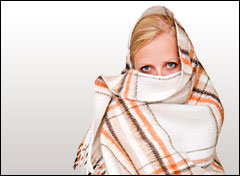Dear Umbra,
In your video advice, you warn people not to set their heat below 55 degrees for fear of frozen pipes. My question is, “On what do you base the 55 degree number?” … I “core heat” with a stove in the fireplace. It heats the core of my house (kitchen and family room) nicely. I let the other parts of my house go to 40-45 degrees when they’re not being used. I’m sure I could safely let them go cooler without danger … Do you have any facts to back up your 55-degree recommendation regarding frozen pipes?
Joe D.
Danbury, Conn.
Dearest Joe,
You bring up an interesting point. Why is 55 degrees so universally favored by the authoritative governmental agencies? Can it be a coincidence that 55 miles per hour is considered the generally most efficient speed of highway travel? And what about Area 51? Does the number five have lobbyists? Perhaps this could be fertile new ground for conspiracy theorists.

I hear your 55 degrees and I’ll raise you 5.
I relayed the 55 degrees recommendation to you from the zillions of government agencies that agree, from the California Consumer Energy Center to your own State of Connecticut. They don’t really provide “facts” to go along with 55. But I have a few ideas about it.
First and foremost, as you know very well, the temperature in a central, heated part of a home is not the same as the temperature in outlying areas. A room can be 55 in the center but have much lower temperatures at the windows, under the windows, within the walls, and of course within the basement or crawlspace. Pipes adjacent to outside walls can become dangerously chilly. In my current domicile, it’s possible to be comfy in the general kitchen, but the cabinets will be filled with freezing air, the microwave interior is decorated with cute little icicles, and I had frozen pipes in the crawlspace last winter.
Let’s say a basement or wall cavity could be 10 degrees colder than the general temperature of a house (a number I picked out of research from the Canadian Center for Housing Technology). If we consider that thermostat recommendations for the general public should contain a generous margin of safety, and pipes will freeze at 31 degrees, then 55 degrees seems a very reasonable suggestion.
Other reasonable reasons for the 55-degree suggestion include that 55 degrees kinda starts to feel cold to most people. It is thought to be an acceptable low temperature in a living space, whereas only hardy folks want their home at 50 or below. Also, on many thermostats the only setting below 55 is “off.” Fifty-five is also a temperature cited in some landlord-tenant laws, as in, when the outside temperature falls below 55 degrees, the unit better be warm inside or the landlord is in trouble.
There are of course exceptions to the 55-degree rule. One is people like yourself, who keep close track of the temperature in all parts of the home, know the location of water pipes, and have the experience to feel confident lowering the temperature without fearing their own personal Old Faithful. Another is folks who use less common heating systems, such as heat pumps and radiant floor heat — the rules for these appear to be different, and temperature setback may not be beneficial, so they don’t want to go down as low as 55. We’ll look into that in a future column.
Each house’s arrangement of water pipes and heat delivery is different. Knowing the facts for your own home, and feeling comfortable with your energy-saving heat settings, is a wonderful thing.
Warmly,
Umbra


